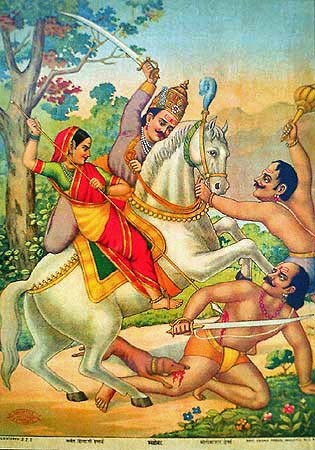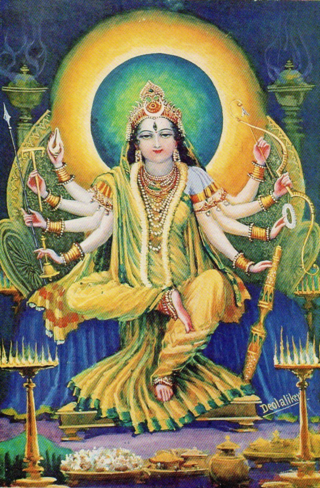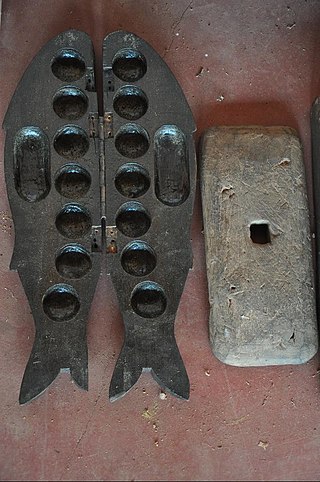
Hindu mythology is the body of myths attributed to, and espoused by, the adherents of the Hindu religion, found in Sanskrit texts such as the Vedic literature, epics like Mahabharata and Ramayana, the Puranas, and mythological stories specific to a particular ethnolinguistic group like the Tamil Periya Puranam and Divya Prabandham, and the Mangal Kavya of Bengal. Hindu myths are also found in widely translated popular texts such as the fables of the Panchatantra and the Hitopadesha, as well as in Southeast Asian texts.

Ardhanarishvara, is a form of the Hindu deity Shiva combined with his consort Parvati. Ardhanarishvara is depicted as half-male and half-female, equally split down the middle. The right half is usually the male Shiva, illustrating his traditional attributes.

Dhumavati is one of the Mahavidyas, a group of ten Hindu Tantric goddesses. Dhumavati represents the fearsome aspect of Mahadevi, the supreme goddess in Hindu traditions such as Shaktism. She is often portrayed as an old, ugly widow, and is associated with things considered inauspicious and unattractive in Hinduism, such as the crow and the chaturmasya period. The goddess is often depicted carrying a winnowing basket on a horseless chariot or riding a crow, usually in a cremation ground.

Rāhu is one of the nine major celestial bodies (navagraha) in Hindu texts and the king of meteors. It represents the ascension of the Moon in its precessional orbit around the Earth, also referred as the north lunar node, and along with Ketu, is a "shadow planet" that causes eclipses. Despite having no physical existence, Rahu has been allocated the status of the planet by ancient seers owing to its strong influence in astrology.

Mohini is the Hindu goddess of enchantment. She is the only female avatar of the Hindu god Vishnu. She is portrayed as a femme fatale, an enchantress, who maddens lovers and demons, sometimes leading them to their doom. Mohini is introduced into Hinduism in the narrative epic of the Mahabharata. Here, she appears as a form of Vishnu following the Churning of the Ocean, a mesmerising beauty who distributes the amrita to the weakened devas (gods) and depriving it to the dominant asuras (demons), allowing the former to defeat the latter with their newfound immortality.

The Tulu people or Tuluvas are an ethno-linguistic and ethno-cultural group from Southern India. They are native speakers of the Tulu language and the region they traditionally inhabit is known as Tulu Nadu. This region comprises the districts of Dakshina Kannada and Udupi in Karnataka and part of Kasaragod district in Kerala, with Mangalore, Karnataka being the commercial hub. The Census report of 2011 reported a population of 1,846,427 native Tulu speakers living in India.
The Bunt people are an Indian community who historically have inhabited the Tulu Nadu region in South India. Bunts were traditionally a warrior-class or martial caste community, with agrarian origins, forming the landed gentry of the region. They are the dominant land-owning and farming community of Tulu Nadu, and speak Tulu as well as Kundagannada as their mother tongue. Today, the Bunts are a largely urbanised community, with a population size of less than one million worldwide.

Khandoba, also known as Martanda Bhairava,, Malhari and Malhar, is a Hindu deity worshiped as a manifestation of Shiva mainly in the Deccan plateau of India, especially in the state of Maharashtra and North Karnataka. He is the most popular Kuladevata in Maharashtra. He is also the patron deity of some warrior, farming castes, 96 kulin kshatriya marathas,shepherd community and Brahmin (priestly) castes as well as several of the hunter/gatherer tribes that are native to the hills and forests of this region. The sect of Khandoba has linkages with Hindu and Jain traditions, and also assimilates all communities irrespective of caste, including Muslims. The form of Khandoba developed during the 9th and 10th centuries from a folk deity into a composite god possessing the attributes of Shiva, Bhairava, Surya and Kartikeya (Skanda). He is depicted either in the form of a linga, or as an image of a warrior riding on a bull or a horse. The foremost centre of Khandoba worship is the temple of Jejuri in Maharashtra. The legends of Khandoba, found in the text Malhari Mahatmya and also narrated in folk songs, revolve around his victory over demons Mani-malla and his marriages.

Būta Kōlā, also referred to as Daiva Kōlā or Daiva Nēmā, is a shamanistic dance performance prevalent among the Hindus of Tulu Nadu and parts of Malenadu of Karnataka and Kasargod in northern Kerala, India. The dance is highly stylized and performed as part of 'Bhootaradhane' or worship of the local deities worshipped by the Tulu speaking population. It has influenced Yakshagana folk theatre. Būta kōlā is closely related to Theyyam of North Malabar region.

A kuladevata, also known as a kuladaivaṃ, is an ancestral tutelary deity in Hinduism and Jainism.

There are many anecdotes of Ganesha. Ganesha's elephant head makes him easy to identify. He is worshipped as the lord of beginnings and as the lord of removing obstacles, the patron of arts and sciences, and the god of intellect and wisdom. Stories about the birth of Ganesha are found in the later Puranas, composed from about 600 CE onwards. References to Ganesha in the earlier Puranas, such as the Vayu and Brahmanda Puranas are considered to be later interpolations made during the 7th to 10th centuries.

Kali or Kalika is a major Hindu goddess associated with time, change, creation, power, destruction and death in Shaktism. Kali is the first of the ten Mahavidyas in the Hindu tantric tradition.

Kaushiki is a Hindu goddess, a deity who emerged from the sheath of Parvati. She was created before Parvati's conflict with the asura brothers Shumbha and Nishumbha, and was also the reason the Matrikas come into existence. According to the Lakshmi Tantra, Kaushiki is a manifestation of the goddess Lakshmi.

Gulikan Theyyam (Thekkan Gulikan) or Guliga Theyyam (Thekkan Guligan) is worshipped as the Lord Shiva. Gulikan Theyyam is part of the Kaliyattam, a popular religious folk dance in the Indian state of Kerala. In the Tulu Nadu region this deity is worshipped as Guliga Daiva, a lord in Hindu Culture.

The Siri Sandhi also Siri Paddana or Epic of Siri is an epic poem in the Tulu language. Consisting of 15,683 lines of poetry, it is the longest poem in Tulu. The epic is essentially a biography of a legendary Bunt princess Siri Alvedi and expands to describe the fate of her progeny – son Kumara, daughter Sonne and grand daughters Abbage and Darage. The epic declares Siri's divinity and also that of her progeny and she is worshipped as a Daiva across Tulu Nadu region of South West India in temples known as Adi Alade. Siri is the patron deity of the Tulu people. Her worship and mass possession cult surrounding her transgresses caste and ethnic lines. The Epic of Siri, though in Tulu, is well known in Kannada speaking populations in and around Tulu Nadu. It is recited in parts in a highly ritual style during the annual festival of Siri Jatre and mass possession festival called Dayyol. Complete recitation of the epic takes close to about 25 hours. The Epic of Siri has been translated into English by Lauri Honko, a Finnish linguo-folklorist.

Kilimarathukavu Siva Parvathy Temple is a Hindu temple located in Kadakkal, Kollam, Kerala, India. It contains the largest cult image of 'Dharma Sastha', an epithet of Ayyappan.
Banga Arasa or Banga Raja is the dynastic title of a medieval ruling family of coastal Karnataka, India. The word Banga is the name of a clan and a surname of the Bunts and the word Arasa or Raja means a ruler in the Tulu language. The dynasty followed the Bunt custom of matrilineal inheritance (Aliyasantana). The Banga Arasas claimed descent from the ancient Alupas and the rulers bore the Alupa royal title Pandyapparasa. The Banga Arasas were said to have been given control of 15 sub-divisions (Magane) of Southern Tulu Nadu by the Hoysala Ballal Emperor, Vira Narasimha. The Banga Arasas ruled from 1224 C.E until the conquest of South Canara by the British in 1799 CE. Descendants of the dynasty survive. However, the family seems to have stopped the coronation ritual after 1889 CE. Since the cessation of the coronation ritual no member of the family has borne the princely title Banga Arasa or Banga Raja instead preferring the aristocratic title Ballal. The dynasty patronized Jainism.They also built Hindu temples as well as shrines to deities of the Buta Kola folk tradition. Ullalthi, a form of the mother goddess worshiped in the Buta Kola tradition was the tutelary deity of the dynasty.
Kiruthivakesvarar Temple is a Hindu temple dedicated to the deity Shiva, located at Soolamangalam near Ayyampet in Thanjavur district in Tamil Nadu, India.















